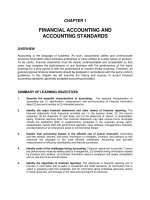Auditing and accounting
Bạn đang xem bản rút gọn của tài liệu. Xem và tải ngay bản đầy đủ của tài liệu tại đây (323.73 KB, 51 trang )
Auditing and
Accounting
Lecture 14 –
Administrative
Processes in
Government
What Is An Audit?
Audit refers to any independent
examination, any objective assessment of
something.
What Is An Audit?
In public administration audit refers to either of
two very common activities.
– The official examination of a financial report
submitted by an individual or organization to
determine whether it accurately represents
expenditures, deductions, or other allowances
determined by laws or regulations; Or.
– The final phase of the government budgetary process,
which reviews the operations of an agency, especially
its financial transactions, to determine whether the
agency has spent its money in accordance with the
law, in the most efficient manner, and with desired
results.
What Is An Audit?
In all cases, an audit connotes comparison with
some standard.
The essence of auditing is measuring something
against a good example to make a critical, an
evaluative, judgment.
Virtually all modern organizations from a local
tennis club to the U.S. Government have auditors
whose basic task is to certify that the financial
accounts of the organization are correct.
What Is An Audit?
Auditing has become a major branch of the
accounting profession, with complex
professional standards and procedures for
admission, practice, and reporting.
The audit of large corporations and
agencies is supposed to certify that they
comply both with the law and with
national accounting standards.
Multiple Applications
Management audit.
– An independent examination of the policies,
practices, and performance of management
functions within an organization.
Multiple Applications
Performance audit.
– An independent examination of the policies, practice,
and performance of an organization to determine if the
desired results or benefits established by the
legislature or other authorizing body are being
achieved.
Efficiency audit.
– An independent examination of the policies, practices,
and performance of an organization to determine if the
organization manages and uses its resources so as to
achieve the maximum benefit at the minimum cost.
Multiple Applications
Other applications.
– Environmental audit to assess compliance with
environmental laws and sound environmental
practices.
– Energy audit to assess the use or waste of energy.
– Water or telecommunications audits to reduce utility
bills.
– Social audit to assess social issues in an organizational
context.
Multiple Applications
Audit processes focus on the present and the
immediate past.
Future audits are usually called impact statements
or assessments.
Audits can be conducted internally or externally.
– Internal audits (conducted by a unit independent of
management) designed to provide objective advice
quickly.
– External audits comes from outside, but also usually
reports outside.
History of Auditing
Government auditing goes back to ancient
times.
– There are records of a Chinese audit function
in the eleventh century B.C. and in Athens in
the fourth century B.C.
History of Auditing
History of Auditing
Modern audit developed in the nineteenth
century when the growth of public sector
activities became so complex that an
independent and objective assessment of
financial management became essential.
With huge sums of money moving around
global empires, the temptation to
corruption was overwhelming.
History of Auditing
Great Britain created its Office of ComptrollerGeneral in 1857.
The U.S. General Accounting Office
(Government Accountability Office in 2004) was
established in 1921.
The establishment of independent auditing
offices helps the audit function stand above
corruption and apart from the political
administration of the day.
History of Auditing
The prestige and renown of the individual
in charge of an audit office can be
important in personifying the integrity and
credibility of the office.
The U.S. Government
Accountability Office
Today most people assume that it is the president
who is responsible for the performance and
accountability of the federal bureaucracy.
In 19th century, it was the responsibility of
Congress.
Beginning in 1901, Teddy Roosevelt began a
two-decade crusade to give the president more
administrative responsibility.
The U.S. Government
Accountability Office
Result: Budgeting and Accounting Act of 1921.
– The “Budgeting” component increased presidential
influence over the budget by creating the Bureau of
the Budget.
– But because Congress did not trust the president, the
second half of the Act (“Accounting”) created the
General Accounting Office as a congressional support
agency to audit federal government expenditures and
to assist the Congress in its legislative oversight
responsibilities.
The U.S. Government
Accountability Office
The GAO is directed by the Comptroller General
of the United States, who is appointed by the
president with the advice and consent of the
Senate for a period of 15 years.
Originally confined itself to auditing financial
records, since 1960s it has redefined its mission
to include overall program evaluations.
The U.S. Government
Accountability Office
Conducts both financial and performance
audits.
In a typical year the GAO completes
around 1,000 major reports for the
members of Congress.
– www.gao.gov.
The U.S. Government
Accountability Office
GAO mission statement:
– We seek to achieve honest, efficient
management and full accountability
throughout government. We serve the public
interest by providing members of congress and
others who make policy with accurate
information, unbiased analysis, and objective
recommendations on how to use public
resources in support of the security and wellbeing of the American people.
The U.S. Government
Accountability Office
Delivered as written reports, congressional
testimony, or formal briefings.
Despite the wide scope of policy and
performance investigations that GAO
undertakes, financial management remains
a central concern.
The U.S. Government
Accountability Office
The GAO with 3,800 accountants, lawyers,
and engineers is the largest government
auditing agency in the United States.
Every major subnational government has
its auditors. They range from the elected
auditor general of a state government to the
local accounting firm retained by a small
school board.
California Bureau of Audits
Welcome to the Bureau of State Audits' home page. We
recognize that the citizens and the government rely on us
to serve as their watchdog to ensure the effective and
efficient administration and management of public funds
and programs. It is our job to help make sure that
California government stays one step ahead. As the
State's independent external auditor, we provide
independent, nonpartisan, accurate, and timely
assessments of California government's financial and
operational activities in compliance with generally
accepted government auditing standards.
/>
Types of Audit
The GAO in its Standards for Audit of
Governmental Organizations, Programs,
Activities, and Functions maintains that a
comprehensive audit program should
include the following three types of audit:
Types of Audit
Financial and compliance:
– Whether the financial statements of an audited
entity present fairly the financial position and
the results of financial operations in
accordance with generally accepted
accounting principles.
– Whether the entity has complied with laws and
regulations that may have a material effect
upon the financial statements.
Types of Audit
Economy and efficiency:
– Whether the entity is managing and utilizing
its resources (such as personnel, property, and
space) economically and efficiently;
– The causes of inefficiencies and uneconomical
practices; and.
– Whether the entity has complied with laws and
regulations concerning matters of economy
and efficiency.









